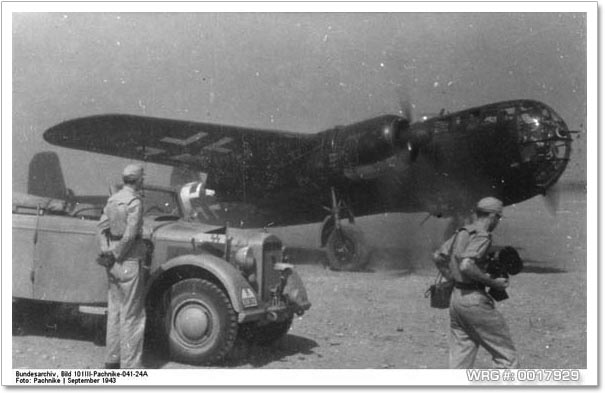Dornier Do 217
Variant: Do 217K
To replace the Do 217, the RLM focussed on the He 177 A-3 and A-5 to be the long-range carrier aircraft for
missiles, owing to the lack of BMW engines to power the Dornier. The Battle of Stalingrad used up more and more
aircrews which prevented them retraining on the Do 217 for glide bomb operations. Owing to problems with the
Heinkel, Air Inspector General Erhard Milch returned his attention to the Do 217 and demanded a greater number
of improved variants for missile operations.

A Dornier Do 217 K, September 1943.
[Source: Bundesarchiv, Bild 101III-Pachnike-041-24A / Pachnike / CC-BY-SA]
In early 1942, tests on a new and improved, completely glazed cockpit enclosure for the Do 217 series had been
underway at the Hamburger Schiffbauanstalt (Hamburg Shipbuilding Institute). E-2s were fitted with a new
streamlined "stepless" cockpit enclosure, the general standard for almost all German bombers later in World
War II, which eliminated the separate windscreen panels for the pilot that earlier versions of the Do 217 had
possessed. The lower nose of the K-version also retained the Bola inverted-casemate gondola for a
rearwards-aimed ventral defensive armament emplacement, with its forward end fully incorporated with the new
nose glazing design. The testing for this new well-framed cockpit glazing format for the later models of the
Do 217 was carried out at the Shipbuilding institute in Hamburg. There, the structural design of the cockpi
t was put to the test using water pressure to simulate a speed of 700 kph. Only a few of the glass panels
failed, and they did so only to inadequate mounting. The cabin design passed the tests easily. Initial
flights took place on 31 March 1942 after inevitable structural issues had been resolved. The first of two
prototypes, the Do 217 K V1 flew with BMW 801A-1s from Löwenthal and Erprobungsstelle Rechlin. This
was followed by the ten-airframe pre-production batch, Do 217 K-01 to K-010. Mass production of the
Do 217 K-1 began at the Dornier factory at Wismar.
The first prototype, a modified E-2 flew on 31 March 1942, with the aircraft showing higher maximum speed owing
to reduced drag. The Do 217 K entered production from September 1942. The type, BMW believed, could reach an
operational ceiling of 7,000m, notwithstanding an A.U.W of 16.8 tonnes. Tests at Peenemünde in June and
July 1943 showed that while the Do 217K could carry and deploy a Fritz-X PGM, it was still controllable.

A Dornier Do 217 K, September 1943.
[Source: Bundesarchiv, Bild 101III-Pachnike-041-24A / Pachnike / CC-BY-SA]
Sources:
Gunston, Bill - The Encyclodepia of the Worlds Combat aircraft, 1976, Chartwell Books, Inc., New York
Brown, Eric, Captain - Wings of the Luftwaffe , 1979, Airlife Publishing Ltd., Shrewsbury
, 1979, Airlife Publishing Ltd., Shrewsbury
Gunston, Bill & Wood, Tony - Hitler's Luftwaffe , 1977, Salamander
Books Ltd., London
, 1977, Salamander
Books Ltd., London
Donald, David - The Complete Encyclopedia Of World Aircraft, 1997, Brown Packaging Books Ltd., London
Wikipedia - Dornier Do 217
Gunston, Bill - The Encyclodepia of the Worlds Combat aircraft, 1976, Chartwell Books, Inc., New York
Brown, Eric, Captain - Wings of the Luftwaffe
Gunston, Bill & Wood, Tony - Hitler's Luftwaffe
Donald, David - The Complete Encyclopedia Of World Aircraft, 1997, Brown Packaging Books Ltd., London
Wikipedia - Dornier Do 217






